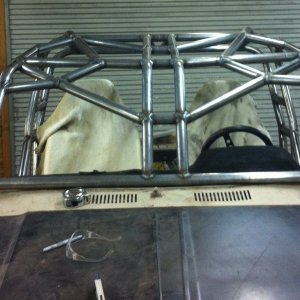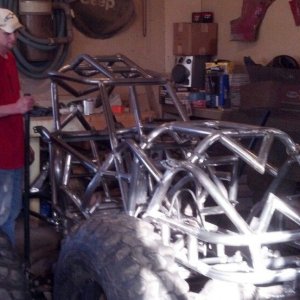Lets see if we can clarify this IFS - SA thing a bit...:haha:
The SA came first. The basic design is simple the components are strong and it works, and so it was used with out challenge for 80-years in 4WD applications under vehicles that were designed to work. :awesomework:
In the late 70's early 80's the "Beancounters" at the manufacturers realized that they could sell the "Safety" of the 4WD far easier if the "Truck" was redesigned to ride like a "Car". :looser: I don't remember who lead the way but I will say that the largest was General Motors and they have not built an adequate 4WD "truck" in 2+decades and that has been reflected by the fact that they have lost the lead to Toyota who builds better "cars". :corn:
Flex is real simple it is the TOTAL amount of wheel movement. Full compression to full droop.
Generally you can get more Flex out of a SA then a 4WD-IFS. The factory IFS typically is limited to about 10-inches some more and quite a few less. This is because the A-Arms (or links if you will) are too short and the angles that the drive shafts run at can not exceed the CV or DOJ mechanical limits. If you do not have MORE flex it is not better flex...
Why do the desert racers or CORR run IFS?
Wheel travel, and Unsprung Weight.
The 2WD design that most desert racers use only looks like the factory design! The sophisticated redesign yields often travel numbers over two feet, but they aren't 4WD. Put the 4WD part back in and the Ford TTB becomes popular at about 16-18 inches maximum.
Yes, the big boys run LT 4WD suspensions that are out into the 24-inch range however with 934-joints and custom 300m shafts they individually cost more then the Toy at the start of this thread!
The SA on a good link design can rather simply be made to travel over 2-feet and there is only one drive shaft and it is long by comparison to an IFS.
Another component to the IFS/SA that plays into this is weight transfer. With the IFS when you drive into/onto something, that wheel moves up (compresses the suspension) and the other wheel remains relatively undisturbed. A good thing for high speed running because at least one wheel is still on the ground steering!
In the SA Design in the same scenario the wheel that moves up is connected to the other wheel by the axle and so there is a direct and immediate shift of weight to the opposite wheel. This is not a good thing when running at speed as it slows down the reaction time of the tire to terrain: tires in the air don't do ****!
However shift out of the desert and into the PNW or rocks and drop the speed to slow to a crawl and that weight transfer becomes important. A tire gains traction because there is weight on it. In the rocks for example on the SA when one tire is forced up the axle acts like a lever and pushes the opposites tire down harder (more traction) the IFS in the same scenario the tire goes up and the opposite tire gains nothing until the body rolls and then there is some weight transfer though never as much as the SA, until right before the flop!
In the desert the suspension "Unsprung Weight" is critical to suspension performance. Unsprung Weight is the weight of everything that is not supported by the springs (duh) you can measure it as the total of the wheel, tire, suspension, axle, etc, and 1/2 the weight of anything that connects to both the wheel and chassis... The more the weight the slower the wheel can react to the terrain it is covering. and if you are racing across the desert you need to have that tire moving as fast as you are. Reducing the Unsprung weight of the suspension by 1 pound has the same effect as reducing the sprung weight by 4-pounds. Switching to an IFS can shave several hundred pounds off the suspension weight (no solid axle) and thus allow the suspension itself to be lightener. Doing all that will let the suspension react faster and give a better, more 'car' like ride and bend flex and self destruct much faster as delivered from the factory... All of which is a good thing if I am the factory as you will like the ride and so pay more for it and I will like the increased maintenance costs when you even slightly FU...
The typical truck on this board can get away with totally ignoring all most all of the elements of suspension design because these types of rigs never move fast. While setting up a good suspension geometry will do nothing but improve the way any truck works in its intended design application you can get away with murder on a SA where the IFS would be an evil handling, tire eating bitch if it was similarly FU!
Next...
The Simplified Universal Combined Thermodynamic Theory of Toasting Bread! :beer:









